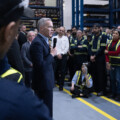This week, Deborah Flint, president and CEO of Toronto Pearson International Airport, wrote in The Hub, kicking off a series discussing what Toronto Pearson Airport, Canada’s largest airport, is currently doing to modernize and compete internationally.
Here are three key takeaways from her article.
1. Airports are economic and regional growth drivers in Canada
Airports, particularly Toronto Pearson Airport, serve as critical economic engines in Canada, significantly impacting regional and national prosperity, explained Flint. The Pearson Economic Zone alone contributes 6 percent of Ontario’s GDP, employs 500,000 people, and anchors Canada’s second-largest employment zone. As demand for air travel rebounds post-pandemic, Pearson projects a 50 percent increase in passenger volume by the early 2030s. This growth emphasizes the airport’s role not just as a transit hub, but as a pillar in Canada’s $100-billion tourism economy, as well as a gateway for global trade.
Pearson’s infrastructure renewal plan, which includes new gates, expanded terminals, and advanced cargo facilities, will ensure it can handle this growth efficiently while maintaining its position as a competitive international hub. These developments reinforce that airports are not just transit points, but components of our global economy.
2. The air sector is now bouncing back post-COVID-19
Contrary to critiques of a weakened aviation sector, Canada’s airports, demonstrate resilience and innovation. While post-pandemic recovery challenges like labour shortages and aircraft supply issues still continue, there is innovation and progress occurring in this rebound period. There is more transparency among service providers and airlines, as passengers are alerted via apps and real-time updates around the status of their flights.
Pearson, which already boasts more international connections than any other North American airport, has implemented 10-year modernization program to keep up with customer feedback on improving the airport. This plan focuses on integrating digital infrastructure and high-speed taxiways for planes on the tarmac. Furthermore, as we respond to climate change, we will be positioning ourselves as a future clean energy hub.
These innovations are essential as air travel demand is expected to double globally in two decades. Canada is poised to benefit from increased accessibility for lower-income travelers from emerging economies.
3. Responding to passenger and industry
The future of airports lies in balancing passenger expectations with operational efficiency. Pearson’s investments in expanded capacity, creation of digital tools, and our new passenger spaces meant to eliminate overcrowding and enhance the travel experience, are key.
Passengers today are demanding seamless navigation, efficiencies, and more retail and leisure offerings. Simultaneously, to compete globally, airlines need modern infrastructure like larger gates and improved cargo facilities. Pearson’s vision also includes using alternative fuels.
By managing costs while delivering large-scale improvements, the airport can be a cornerstone of Canada’s transportation future and a driver of national economic growth.
ChatGPT assisted in the creation of this article.








